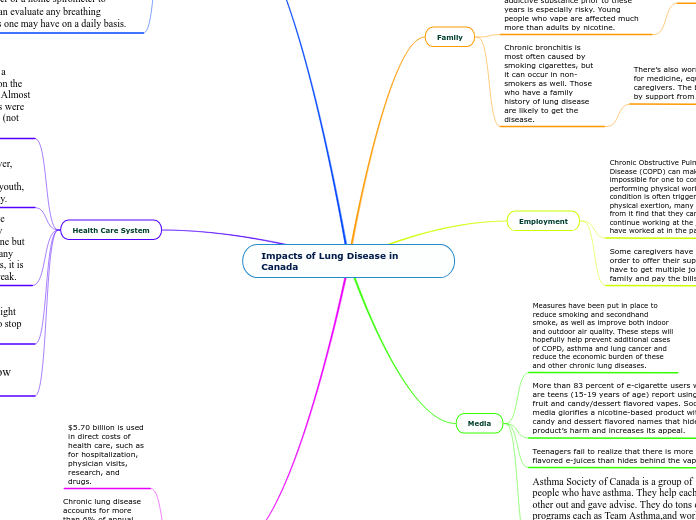Impacts of Lung Disease in Canada
Economy
Donating money from 1$ to 50$ helps patients pay for treatments and doctor appointments.
Costs attributable to COPD were $32.1 billion in 2010 however the amount has increased from 32.1 billion to $49.0 billion by 2020.
Chronic lung disease accounts for more than 6% of annual health-care costs in Canada,
$5.70 billion is used in direct costs of health care, such as for hospitalization, physician visits, research, and drugs.
Health Care System
Pulmonary function tests are noninvasive tests that show how well the lungs are working.
Stronger laws, including FDA oversight over tobacco products, are needed to stop kids from smoking and vaping.
Tobacco contains the highly addictive substance nicotine. Smokers not only become physically addicted to nicotine but because they also link smoking to many daily activities and social interactions, it is an extremely difficult addiction to break.
Most adults about 76 percent began smoking when they were 18. However, electronic cigarettes are the most commonly used tobacco product in youth, and 5,700 kids start vaping every day.
Respiratory diseases exercise a significant economic impact on the Canadian health care system. Almost 6.5% of total health care costs were related to respiratory diseases (not including lung cancer).
Individuals
Individuals with asthma can use a peak flow meter or a home spirometer to monitor an evaluate any breathing problems one may have on a daily basis.
Secondhand smoke has been linked to lung cancer
Lung cancer remains the leading cause of death from cancer for both genders.
Both men and women especially women who chose to smoke are at risks of developing diseases such as lung cancer and COPD among women.
Tobacco remains the most important preventable risk factor for chronic respiratory diseases. One in five Canadians currently smoke cigarettes.
Smoking cessation among adults would have the greatest impact on reducing respiratory diseases, such as lung cancer and COPD.
Media
Asthma Society of Canada is a group of people who have asthma. They help each other out and gave advise. They do tons of programs each as Team Asthma,and work on engaging new patients with their own care.
Teenagers fail to realize that there is more to flavored e-juices than hides behind the vapor.
More than 83 percent of e-cigarette users who are teens (15-19 years of age) report using fruit and candy/dessert flavored vapes. Social media glorifies a nicotine-based product with candy and dessert flavored names that hide the product’s harm and increases its appeal.
Measures have been put in place to reduce smoking and secondhand smoke, as well as improve both indoor and outdoor air quality. These steps will hopefully help prevent additional cases of COPD, asthma and lung cancer and reduce the economic burden of these and other chronic lung diseases.
Employment
Some caregivers have to quit their jobs in order to offer their support. While others have to get multiple jobs to support the family and pay the bills.
Chronic Obstructive Pulmonary Disease (COPD) can make it impossible for one to continue performing physical work. The condition is often triggered by physical exertion, many who suffer from it find that they can no longer continue working at the jobs they have worked at in the past.
Family
Chronic bronchitis is most often caused by smoking cigarettes, but it can occur in non-smokers as well. Those who have a family history of lung disease are likely to get the disease.
There’s also worry about the cost of paying for medicine, equipment, doctors, and other caregivers. The burden here may be allayed by support from other family and friends.
Vaping exposes teenagers to nicotine at a time when the brain is most at risk for addiction. The brain continues to develop until early adulthood, roughly age 25-30, use of any addictive substance prior to these years is especially risky. Young people who vape are affected much more than adults by nicotine.
There’s also stress, such as due to the financial impact of the illness.

